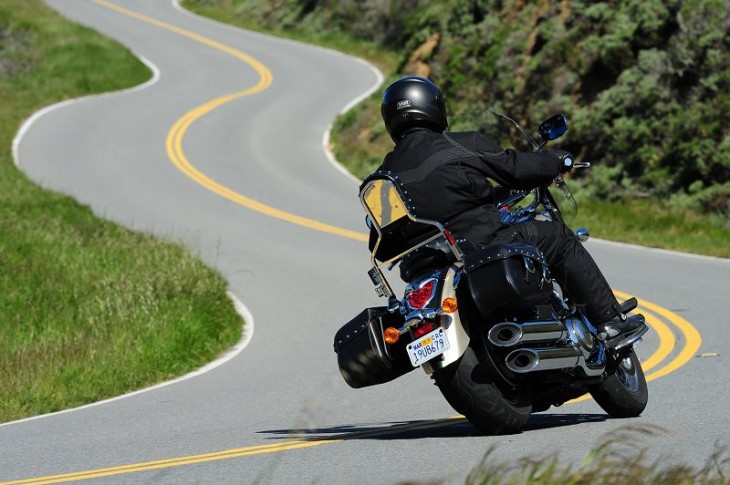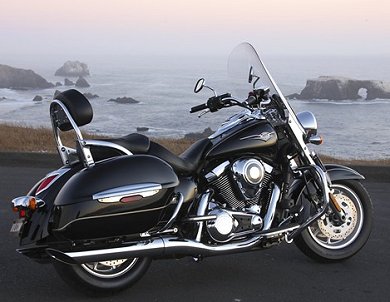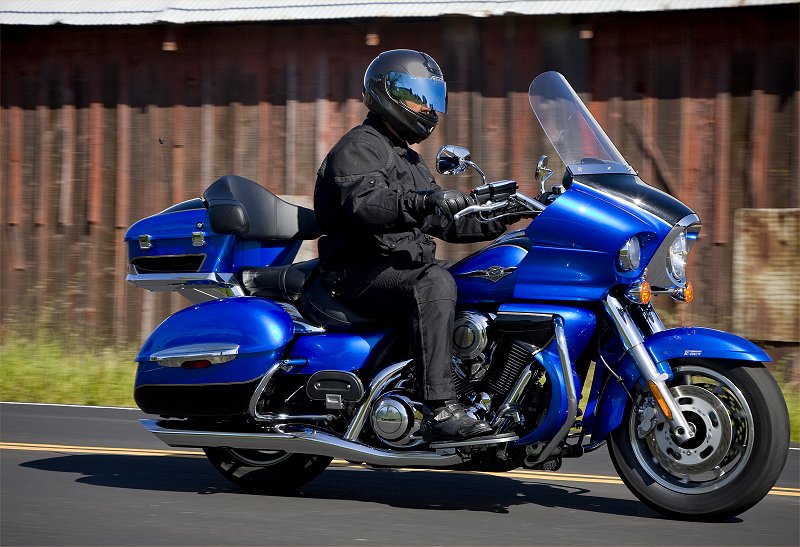
Vulcan 1700 Voyager
Press introductions for large-displacement cruisers aren’t quite what they used to be. Perhaps it’s ancient history now, but there was a time when larger cruisers had a single, largely inadequate front disc brake (and sometimes even a drum brake in the rear), squishy suspension, wallowy chassis and severely limited ground clearance. Press intros for these beasts involved a very orderly, pedestrian-paced, follow-the-leader-and-look-at-the-pretty-scenery ride. The contrast with a sport bike press introduction, where testosterone-fueled journalists frequently went into full race mode on the street, couldn’t have been more dramatic.
On the afternoon of my first day testing Kawasaki’s 1700cc Vulcan cruisers in Northern California a couple of weeks ago, the old style of cruiser press intro couldn’t have been further from my mind. At the time, I was aboard Kawasaki’s new Nomad, and I was chasing Kawasaki press representative Greg Lasiewski (riding two-up on the full dress Voyager) through a very twisty road that passes the front gate to producer George Lucas’ ranch. The road is known as Lucas Valley Road (not named for the famous Star Wars producer). I had purposely put myself at the head of the group of journalists I was riding with, right behind Greg, hoping for an opportunity to press the pace a bit on this fabulous road with its rhythmic turns and overhanging trees. When we were through, the rest of the journalists needed a minute or so to catch back up, but I think both Greg and I had big smiles plastered on our faces.
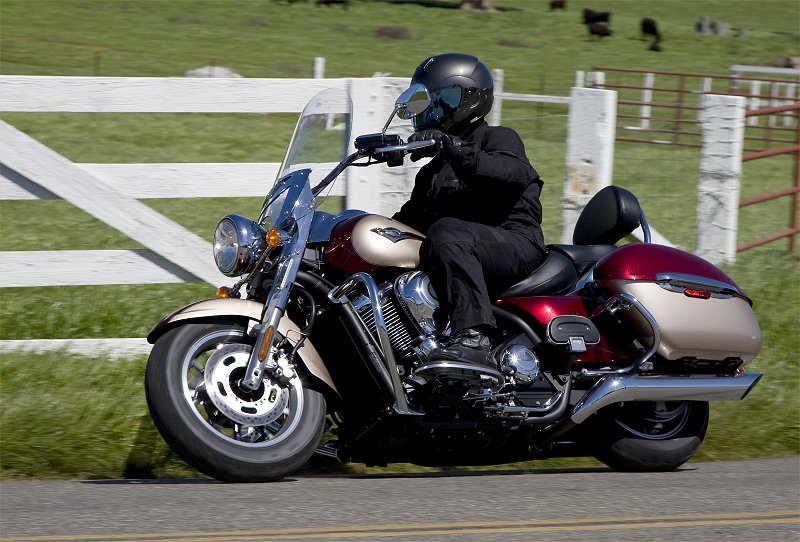
Vulcan 1700 Nomad
Had Greg been without a passenger, I know we could have gone a fair bit faster, but the pace we carried was already impressive aboard 1700cc, 800+ pound, traditionally styled v-twin cruisers. I have probably ridden other cruisers that quickly through the twisties (although not more than one or two other times), but never with so little drama. Trail braking into corners, tossing the big machine from one side to another when changing directions, and even casually noting just how much the floorboards were folding up in the corners (in order to avoid grounding something fixed), it was literally a walk in the park. “Confidence inspiring” is the catch phrase, but in retrospect, that would be an understatement given the size and the weight of the machinery we were aboard.
This little anectode might tell you more about where Kawasaki is coming from with its new Vulcan 1700 series than all of the somewhat tedious detail I am about to tell you. Kawasaki doesn’t mince words these days. The company is focused on performance, and the category involved doesn’t matter. Of course, competition is fierce among all of the motorcycle manufacturers, and the large displacement cruiser category presents some of the most stout competition of all. Kawasaki had their work cut out for them when trying to develop a line of motorcycles that stood out from the alternatives available to consumers. One way to do this, of course, is to introduce a machine with features simply unavailable anywhere else.
Kawasaki has tried to do that with the new full dress tourer, the Vulcan 1700 Voyager. Kawasaki boasts that this is the first metric full-dress v-twin touring motorcycle available for sale here. The key words would be “metric” and “v-twin”. Yamaha has sold a classically-styled v-four full-dress tourer for some time and, of course, Harley-Davidson has offered the Electra Glide and associated family members, for decades. But if you want a “metric” full dress tourer with a v-twin, Kawasaki is your only choice at the moment.
Kawasaki also took the time to contrast the new Voyager with Victory’s Vision Tourer (powered by a domestic v-twin) from a styling perspective. Kawasaki correctly points out that the Vision tends to have a polarizing effect on consumers (i.e., they love its looks, or they hate it). It is also correctly noted by Kawasaki that the Vision is anything but “traditional” from a styling perspective. More reasons Kawasaki feels the new Voyager has found a market niche to call its own.
What underpins the new Voyager, and each of these new Vulcan 1700s, is new design and engineering. An entirely new 1700cc (yes, exactly 1700cc or 103.7 cubic inches) liquid cooled, 50 degree v-twin powers each of the four models. It is fuel injected and controlled by a drive-by-wire electronic throttle valve (ETV). A powerful ECU is used to maximize performance and fuel efficiency.
Those big power pulses get to the rear wheel through a six-speed, overdrive transmission and carbon belt final drive. That belt more efficiently transfers crank horsepower to the rear wheel than the old shaft drive system, and Kawasaki claims the new 1700 puts out 15% more torque and 20% more horsepower than the old Vulcan 1600 despite a displacement increase of less than 10%.
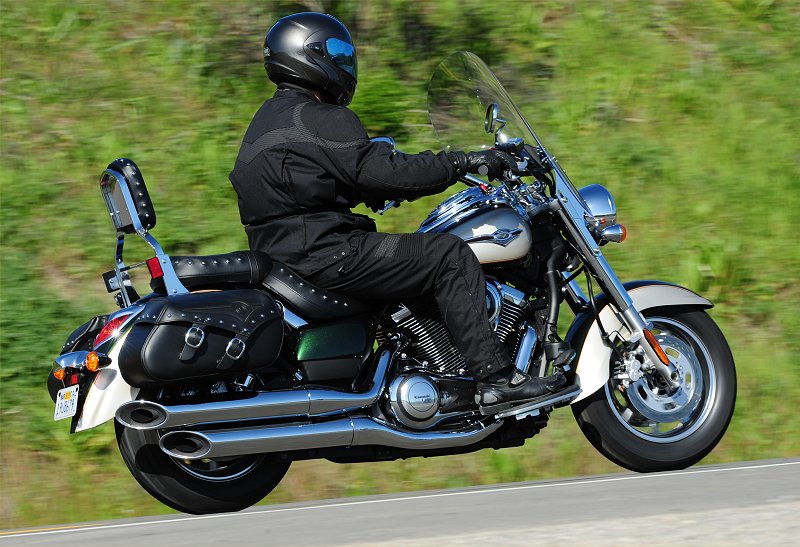
Vulcan 1700 Classic LT
Interestingly, Kawasaki moved the powerband around on the various models. The “touring” models, including the Nomad and the Voyager, make their peak horsepower at 5000 rpm (vs. 4500 rpm on the Classic models) and 108 foot pounds of torque at 2750 rpm (vs. that same peak at 2250 rpm on the Classic models).

Although the Vulcan 1600 was hardly criticized for poor handling (we thought it handled quite well, actually), Kawasaki really tried to move the goal posts with its new chassis. A massive 40% more rigid than the old frame, that new chassis is also more compact. A shorter wheelbase combines with tweaked steering geometry to improve, according to Kawasaki, both stability and turning. The chassis also allows more compact ergonomics, including a 30mm shorter reach to the handlebar, and a 50mm shorter reach from the seat to the floorboards.
The 43mm inverted front forks are non-adjustable, while the rear shocks allow adjustment of air pressure (from a stock 0 psi to 43 psi) and four-way rebound damping.
New styling utilizes genuine, steel fenders, and incorporates a large, 5.3 gallon fuel tank. All of the bikes (save the Voyager) have traditional gas tank mounted instrumentation that incorporates a fuel gauge, fuel consumption read-out (including range to empty and average mpg) odometer, clock, two trip meters and a gear position indicator. The ignition, together with an integrated fork lock, is mounted conveniently near the steering head.

Vulcan 1700 Classic
Incorporating all these features is the simple Classic model, available only in Metallic Diablo Black at a U.S. MSRP of $12,299. The Classic LT, on the other hand, adds standard two-tone paint, height adjustable windshield, studded seats, and passenger backrest. The LT also gets leather saddle bags that are reinforced in certain areas to better hold their shape and improve functionality. Paint schemes available for the LT include Metallic Nocturne Blue/Pearl Burnish Beige and Metallic Dark Green/Pearl Burnish Beige. U.S. MSRP is $13,799, and Kawasaki points out that adding the LT accessories to the Classic would cost you approximately $1,200 more than the price of the LT.
Both the new Nomad and Voyager feature “tuned for touring” engine, exhaust, suspension and floorboards that differ from the Classic models. The Nomad has these “tuned for touring” features, plus, in comparison to the Classic LT, a touring seat, lockable color-matched saddlebags and cruise control.
The dual exhausts on the Nomad are mounted on each side of the bike to keep them low and out of the way of the hard saddle bags. The Nomad’s spring and damping rates are higher than those found on the Classic models, while the shocks feature the same adjustability (air pressure and four-way rebound). Ergos are tweaked slightly on the Nomad with the floorboards moved 30mm behind those found on the Classic models.
The hard bags on the Nomad appear well made and durable. They open from the top and feature chrome handles and dual latches. Capacity appears pretty generous and is rated at 10 gallons each. They are lockable and keyed to match the bike ignition. The Nomad chassis features standard front and rear engine guards.
The cruise control found on both the Nomad and Voyager is pretty sophisticated, and worked seamlessly during our testing. It features fine speed adjustment (one “tap” equals a 1 mile per hour adjustment). It is easily overridden with throttle or brake. The Vulcan 1700 Nomad is available in Metallic Diablo Black at a U.S. MSRP of $14,399 and in Candy Diamond Red/Pearl Lustre Beige at $14,699
The new flagship tourer is the full-dress Vulcan 1700 Voyager. With the touring market growing (despite the overall market for motorcycles shrinking), Kawasaki really pulled out all the stops on the new Voyager. The frame mounted fairing keeps wind forces from impacting your steering of the big bike, and it is shaped in a classic, yet unique “muscle car” theme that we found very effective at providing wind protection on the highway. It also incorporates two auxillary headlights.
All of the features of the 1700 Nomad migrate over to the Voyager, but Kawasaki adds quite a bit more. In addition to that frame mounted fairing, integrated lowers help keep wind off your legs and feet, and a full array of instrumentation and audio features are exclusive to the Voyager.
The “dash” of the Voyager provides just about every feature you would find on a modern automobile. In addition to integrated cruise control (controlled at the handlebar), all of the instrumentation and gauges found on modern sport tourers is available (including a computer that provides both average fuel consumption and remaining fuel range). The main gauges are analog and very legible, while the LED screen in the center also provides good contrast and was easily read even in bright sunlight.
The integrated sterio is iPod ready, incorporates a rider-passenger intercom capability, and is also designed to accept dual rear speakers, XM radio and CB radio. We found the radio had good volume and tone, although we had difficulty locating decent radio signals in the area of California where we were testing. The radio can be controlled completely from the handlebars, and is rated at 88 watts.
In addition to the large hardbags found on the Nomad, the Voyager gets a large integrated trunk capable of holding two full-face helmets – rated at 13.2 gallons in capacity. It is also lockable, but, like the side bags, can be left unlocked and accessed without the key. The trunk has an integrated LED tail light/stop light that supplements the standard tail light found on the other models.
While all of the new Vulcan 1700 machines feature 300mm dual disc brakes in front, only the Voyager has four-piston calipers (the other bikes feature twin piston calipers). All the models have a single 300mm disc gripped by a dual piston caliper out back. The Voyager is actually available with or without a sophisticated ABS system developed by Kawasaki and called K-ACT. K-ACT is a very complicated system that I will not attempt to explain fully here. Suffice it to say that it is not a simple “combined braking” system; according to Kawasaki it is a “smart system” that evaluates numerous factors before distributing braking forces optimally. We rode a K-ACT equipped Voyager and found its braking performance virtually seamless, with no pulsing or other obvious indications we were dealing with a combined ABS system.
We rode all four bikes over two days covering varied road conditions. From high speed freeway travel to tight, slow twisty roads, and everything in between. These bikes handle extremely well for the segment, and the engine performance was outstanding. Throttle response is crisp and fueling is smooth without any jerking associated with off/on throttle transitions. The frames were obviously stiff for this category of motorcycle, and contributed to surprisingly light steering, even at lower speeds.
Brake performance was also excellent throughout this range of motorcycles, with both good feel and power found on all models. We preferred the suspension setting on the “Touring” models (the Voyager and Nomad), which was a bit stiffer and allowed for more spirited handling, but the softer suspension found on the “Classic” models was not easy to criticize given its intended customer base.
Before I got on the bikes for the first time, I thought the shorter distance between seat and floorboards on these new models might prove uncomfortable. I envisioned my knees bent at tight, uncomfortable angles. In the end, my 5’10” frame (and 31″ inseam) didn’t complain, even after some fairly extended stints in the saddle.
Speaking of the saddle, I preferred the more plush touring saddles found on the Nomad and Voyager models, although again Kawasaki designed the firmer saddles on the Classic and Classic LT to work well for their slightly different missions (i.e., shorter trips). None of the bikes provided “hot spots” or significant discomfort even after several hours of riding.
Wind screen height is always a very personal issue for riders, myself included. I am not very tall, but I sit fairly tall in the saddle, and actually preferred the screen height I found on the Classic LT and the Nomad when compared to the new Voyager. Although the Voyager provides outstanding overall wind protection, I did not like looking through the top of the windscreen, and would have preferred a shorter screen. Kawasaki will undoubtedly have optional screens for all of these bikes but as it stands the Voyager screen is fixed in place, while the screens on the Nomad and the Classic LT are height adjustable.
The full dress Vulcan 1700 Voyager and Voyager ABS are featured in two color schemes, including Candy Plasma Blue/Metallic Diablo Black and Metallic Titanium/Metallic Diablo Black. The standard Voyager is available at a U.S. MSRP of $16,799, while the ABS model retails for $17,899.
These new Vulcan 1700s combine the classic styling cruiser riders are looking for with extremely modern engine and chassis features that work together to provide riding performance virtually unknown to cruiser enthusiasts just a few years ago. For additional details and specifications, visit Kawasaki’s web site where you can also browse some of the many accessories Kawasaki has available to personalize their new Vulcans
